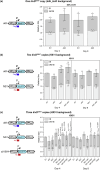Development of a CRISPR activation system for targeted gene upregulation in Synechocystis sp. PCC 6803
- PMID: 40399557
- PMCID: PMC12095680
- DOI: 10.1038/s42003-025-08164-y
Development of a CRISPR activation system for targeted gene upregulation in Synechocystis sp. PCC 6803
Abstract
The photosynthetic cyanobacterium Synechocystis sp. PCC 6803 offers a promising sustainable solution for simultaneous CO2 fixation and compound bioproduction. While various heterologous products have now been synthesised in Synechocystis, limited genetic tools hinder further strain engineering for efficient production. Here, we present a versatile CRISPR activation (CRISPRa) system for Synechocystis, enabling robust multiplexed activation of both heterologous and endogenous targets. Following tool characterisation, we applied CRISPRa to explore targets influencing biofuel production, specifically isobutanol (IB) and 3-methyl-1-butanol (3M1B), demonstrating a proof-of-concept approach to identify key reactions constraining compound biosynthesis. Notably, individual upregulation of target genes, such as pyk1, resulted in up to 4-fold increase in IB/3M1B formation while synergetic effects from multiplexed targeting further enhanced compound production, highlighting the value of this tool for rapid metabolic mapping. Interestingly, activation efficacy did not consistently predict increases in compound formation, suggesting complex regulatory interactions influencing bioproduction. This work establishes a CRISPRa system for targeted upregulation in cyanobacteria, providing an adaptable platform for high-throughput screening, metabolic pathway optimisation and functional genomics. Our CRISPRa system provides a crucial advance in the genetic toolbox available for Synechocystis and will facilitate innovative applications in both fundamental research and metabolic engineering in cyanobacteria.
© 2025. The Author(s).
Conflict of interest statement
Competing interests: The authors declare no competing interests.
Figures








Similar articles
-
dCas12a-mediated CRISPR interference for multiplex gene repression in cyanobacteria for enhanced isobutanol and 3-methyl-1-butanol production.Microb Cell Fact. 2025 May 13;24(1):104. doi: 10.1186/s12934-025-02727-8. Microb Cell Fact. 2025. PMID: 40361099 Free PMC article.
-
Protein engineering of α-ketoisovalerate decarboxylase for improved isobutanol production in Synechocystis PCC 6803.Metab Eng. 2018 May;47:42-48. doi: 10.1016/j.ymben.2018.02.014. Epub 2018 Mar 1. Metab Eng. 2018. PMID: 29501927
-
Light-induced production of isobutanol and 3-methyl-1-butanol by metabolically engineered cyanobacteria.Microb Cell Fact. 2022 Jan 6;21(1):7. doi: 10.1186/s12934-021-01732-x. Microb Cell Fact. 2022. PMID: 34991586 Free PMC article.
-
Approaches in the photosynthetic production of sustainable fuels by cyanobacteria using tools of synthetic biology.World J Microbiol Biotechnol. 2021 Oct 19;37(12):201. doi: 10.1007/s11274-021-03157-5. World J Microbiol Biotechnol. 2021. PMID: 34664124 Review.
-
Challenges and opportunities with CRISPR activation in bacteria for data-driven metabolic engineering.Curr Opin Biotechnol. 2020 Aug;64:190-198. doi: 10.1016/j.copbio.2020.04.005. Epub 2020 Jun 27. Curr Opin Biotechnol. 2020. PMID: 32599515 Review.
Cited by
-
Directed evolution of α-ketoisovalerate decarboxylase for improved isobutanol and 3-methyl-1-butanol production in cyanobacteria.Biotechnol Biofuels Bioprod. 2025 Jul 31;18(1):84. doi: 10.1186/s13068-025-02687-6. Biotechnol Biofuels Bioprod. 2025. PMID: 40745552 Free PMC article.
References
-
- Yoo, D. et al. Metabolic engineering for redirecting carbon to enhance the fatty acid content of Synechocystis sp. PCC6803. Biotechnol. Bioprocess Eng.28, 274–280 (2023).
MeSH terms
Substances
Grants and funding
LinkOut - more resources
Full Text Sources

